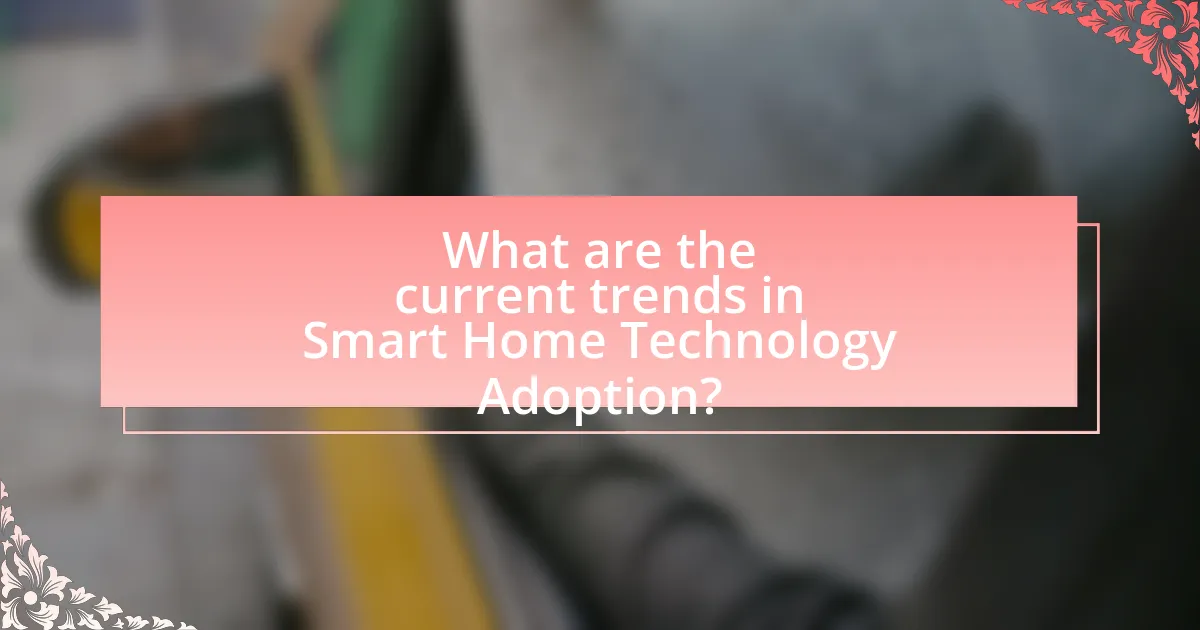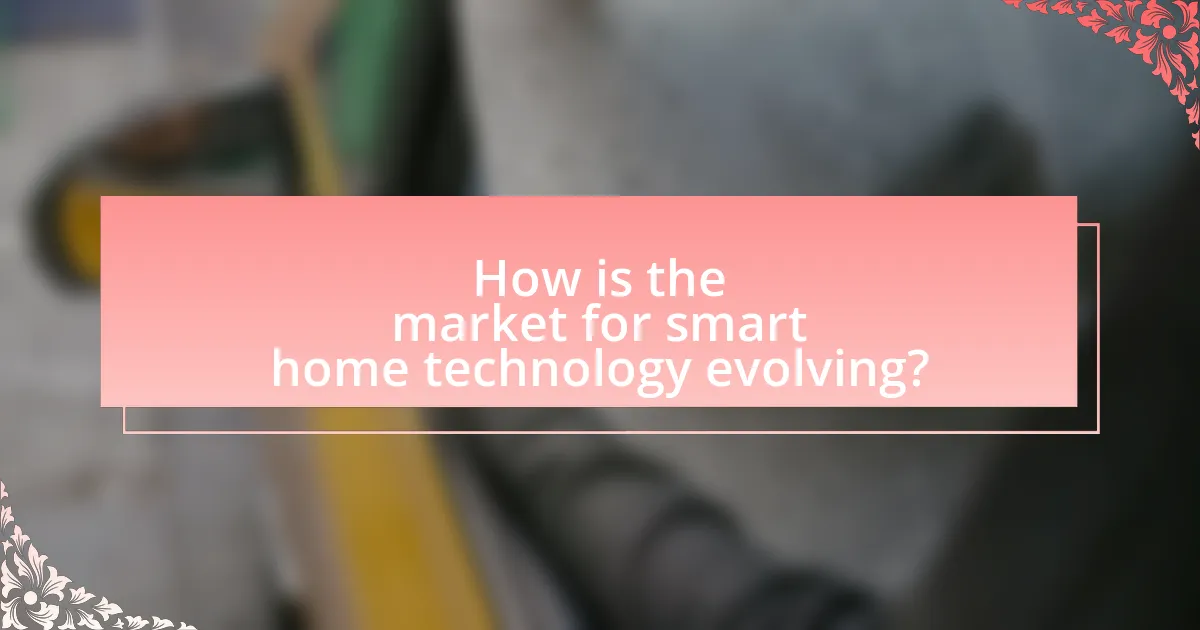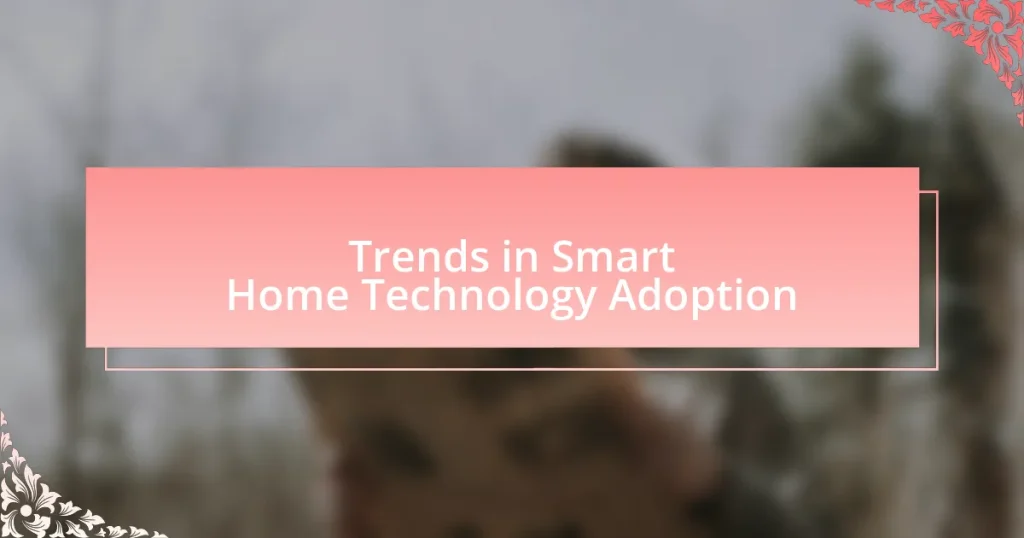The article focuses on current trends in smart home technology adoption, highlighting the integration of artificial intelligence, energy efficiency, and the rise of voice-activated devices. It examines the evolving consumer interest in smart home technologies, influenced by demographic factors such as age, income, and education level. Additionally, the article discusses lifestyle changes driving adoption, key drivers like convenience and security, and challenges such as high costs and privacy concerns. It also explores the role of emerging technologies, market forecasts, and practical considerations for consumers when adopting smart home solutions.

What are the current trends in Smart Home Technology Adoption?
Current trends in smart home technology adoption include increased integration of artificial intelligence, a growing emphasis on energy efficiency, and the rise of voice-activated devices. The integration of AI allows for more personalized user experiences, enabling devices to learn and adapt to individual preferences. Energy efficiency is becoming a priority as consumers seek to reduce utility costs and environmental impact, leading to the adoption of smart thermostats and energy monitoring systems. Additionally, the popularity of voice-activated devices, such as smart speakers, has surged, with a report from Statista indicating that the global smart speaker market is projected to reach 35 million units sold by 2025. These trends reflect a shift towards more connected, efficient, and user-friendly smart home environments.
How is consumer interest in smart home technology evolving?
Consumer interest in smart home technology is rapidly increasing, driven by advancements in technology and growing awareness of its benefits. According to a report by Statista, the global smart home market is projected to reach approximately $135 billion by 2025, indicating a significant rise in consumer adoption. Additionally, a survey conducted by the Consumer Technology Association found that 69% of U.S. households own at least one smart home device, reflecting a growing trend towards integrating smart technology into daily life. This evolution is further supported by the increasing availability of affordable smart devices and the rising demand for home automation solutions that enhance convenience, security, and energy efficiency.
What demographic factors influence smart home technology adoption?
Age, income, education level, and household composition are key demographic factors influencing smart home technology adoption. Research indicates that younger individuals, particularly those aged 18-34, are more likely to adopt smart home technologies due to their familiarity with technology and higher comfort levels. Higher income levels correlate with increased adoption rates, as individuals with greater financial resources can afford the initial investment in smart devices. Additionally, individuals with higher education levels tend to adopt smart home technologies more readily, as they often have better access to information and understanding of the benefits. Lastly, households with children are more inclined to adopt smart home technologies for enhanced security and convenience, as evidenced by studies showing that families prioritize safety features in their smart home systems.
How do lifestyle changes impact the adoption of smart home technologies?
Lifestyle changes significantly enhance the adoption of smart home technologies by aligning technological solutions with evolving consumer needs. As individuals increasingly prioritize convenience, energy efficiency, and security in their daily lives, they are more inclined to integrate smart devices that offer these benefits. For instance, a survey by Statista in 2021 indicated that 63% of respondents cited convenience as a primary reason for adopting smart home technologies, reflecting a shift in lifestyle towards automation and ease of use. Additionally, the growing trend of remote work has led to increased interest in home automation for improved comfort and productivity, further driving the adoption of smart home solutions.
What are the key drivers behind the adoption of smart home technologies?
The key drivers behind the adoption of smart home technologies include convenience, energy efficiency, security, and the growing integration of the Internet of Things (IoT). Convenience is a primary factor, as smart home devices allow users to automate tasks and control their home environment remotely, enhancing daily life. Energy efficiency is increasingly important; smart thermostats and lighting systems can significantly reduce energy consumption, leading to cost savings and environmental benefits. Security concerns also drive adoption, with smart cameras and alarm systems providing enhanced monitoring and peace of mind. Furthermore, the integration of IoT facilitates seamless communication between devices, making smart home systems more appealing and functional. According to a report by Statista, the global smart home market is projected to reach $174 billion by 2025, highlighting the increasing consumer interest and investment in these technologies.
How does convenience play a role in the adoption of smart home devices?
Convenience significantly influences the adoption of smart home devices by simplifying daily tasks and enhancing user experience. Smart home devices automate routine activities, such as adjusting lighting, controlling temperature, and managing security systems, which saves time and effort for users. According to a 2021 survey by Statista, 63% of respondents cited convenience as a primary reason for integrating smart home technology into their lives. This ease of use encourages more consumers to invest in smart devices, leading to increased market growth and widespread acceptance of smart home solutions.
What security concerns are influencing consumer decisions?
Security concerns significantly influencing consumer decisions include data privacy, unauthorized access, and device vulnerabilities. Consumers are increasingly worried about how their personal information is collected, stored, and potentially misused by smart home devices. A survey conducted by the Consumer Technology Association in 2022 revealed that 70% of consumers expressed concerns about data breaches and hacking incidents related to smart home technology. Additionally, the potential for unauthorized access to home networks through insecure devices raises alarms, as evidenced by reports from cybersecurity firms indicating a rise in IoT-related attacks. These factors collectively shape consumer hesitance and decision-making regarding the adoption of smart home technologies.
What challenges are faced in the adoption of smart home technologies?
The adoption of smart home technologies faces several challenges, including high costs, interoperability issues, and privacy concerns. High costs deter many consumers from investing in smart home devices, as initial setup and ongoing maintenance can be expensive. Interoperability issues arise when devices from different manufacturers do not communicate effectively, leading to a fragmented user experience. Privacy concerns are significant, as users worry about data security and unauthorized access to their personal information, which can hinder trust in these technologies. According to a 2021 survey by the Consumer Technology Association, 45% of consumers cited privacy as a major barrier to adopting smart home devices, highlighting the importance of addressing these challenges for wider acceptance.
How do compatibility issues affect consumer adoption?
Compatibility issues significantly hinder consumer adoption of smart home technology. When devices from different manufacturers do not work seamlessly together, potential users often experience frustration and confusion, leading to reluctance in purchasing or integrating these technologies into their homes. For instance, a survey by the Consumer Technology Association found that 70% of consumers cited compatibility with existing devices as a major concern when considering smart home products. This highlights that without standardized protocols or interoperability, consumers are less likely to invest in smart home solutions, ultimately stalling market growth.
What are the common misconceptions about smart home technology?
Common misconceptions about smart home technology include the belief that it is overly complicated, excessively expensive, and insecure. Many people think that smart home devices require extensive technical knowledge to operate, but most systems are designed for user-friendliness, allowing easy setup and control through mobile apps. Additionally, while initial costs can be high, the long-term savings on energy bills and increased home value often offset these expenses. Concerns about security are prevalent, yet reputable smart home devices incorporate robust encryption and security measures to protect user data, making them safer than many traditional systems.

How is the market for smart home technology evolving?
The market for smart home technology is rapidly evolving, driven by increasing consumer demand for convenience, security, and energy efficiency. According to a report by Statista, the global smart home market is projected to reach approximately $174 billion by 2025, reflecting a compound annual growth rate of around 25% from 2020. This growth is fueled by advancements in Internet of Things (IoT) technology, which enables seamless integration of devices, and the rising popularity of voice-activated assistants, such as Amazon Alexa and Google Assistant. Additionally, the COVID-19 pandemic has accelerated the adoption of smart home solutions as more consumers prioritize home automation for enhanced living experiences.
What are the emerging technologies in the smart home market?
Emerging technologies in the smart home market include artificial intelligence (AI), Internet of Things (IoT) devices, smart home security systems, and energy management solutions. AI enhances automation and personalization, allowing devices to learn user preferences and optimize performance. IoT devices enable seamless connectivity and communication between various home appliances, improving user control and convenience. Smart home security systems utilize advanced sensors and cameras for real-time monitoring and alerts, increasing safety. Energy management solutions, such as smart thermostats and energy-efficient appliances, help reduce energy consumption and costs. According to a report by MarketsandMarkets, the smart home market is projected to grow from $80.21 billion in 2022 to $135.3 billion by 2025, highlighting the increasing adoption of these technologies.
How are advancements in AI and IoT shaping smart home devices?
Advancements in AI and IoT are significantly enhancing the functionality and user experience of smart home devices. AI enables devices to learn user preferences and behaviors, allowing for personalized automation, such as adjusting lighting and temperature based on individual routines. IoT connects these devices to the internet, facilitating real-time data exchange and remote control through smartphones or voice assistants. For instance, a study by Statista in 2023 indicated that 70% of smart home device users reported increased convenience due to AI-driven automation. This integration of AI and IoT not only improves energy efficiency but also enhances security features, as devices can communicate and respond to potential threats more effectively.
What role do smart assistants play in the evolution of smart homes?
Smart assistants serve as the central control hub in the evolution of smart homes, enabling seamless integration and management of various smart devices. They facilitate voice-activated commands, allowing users to control lighting, temperature, security systems, and appliances through simple verbal instructions. According to a report by Statista, the global smart speaker market is projected to reach 35 million units by 2025, highlighting the increasing reliance on smart assistants in households. This growth underscores their role in enhancing user convenience and promoting the adoption of smart home technologies.
What are the market forecasts for smart home technology adoption?
The market forecasts for smart home technology adoption indicate significant growth, with projections estimating the global smart home market to reach approximately $174 billion by 2025, growing at a compound annual growth rate (CAGR) of around 25%. This growth is driven by increasing consumer demand for convenience, energy efficiency, and enhanced security features. According to a report by MarketsandMarkets, the adoption of smart home devices is expected to rise due to advancements in Internet of Things (IoT) technology and the proliferation of smart devices, which are anticipated to enhance connectivity and automation in households.
How are different regions adopting smart home technologies?
Different regions are adopting smart home technologies at varying rates influenced by factors such as economic development, consumer preferences, and regulatory environments. For instance, North America leads in adoption due to high disposable income and a strong focus on home automation, with approximately 30% of households utilizing smart devices as of 2023. In contrast, Europe shows a growing trend, particularly in countries like Germany and the UK, where energy efficiency and sustainability drive adoption, with around 25% of homes equipped with smart technology. Meanwhile, Asia-Pacific, particularly China, is rapidly increasing its adoption rate, fueled by urbanization and technological advancements, with estimates suggesting that over 20% of households will integrate smart home devices by 2025. These statistics highlight the diverse landscape of smart home technology adoption across different regions.
What is the projected growth rate of the smart home market?
The projected growth rate of the smart home market is expected to reach a compound annual growth rate (CAGR) of approximately 25% from 2023 to 2030. This significant growth is driven by increasing consumer demand for convenience, energy efficiency, and enhanced security features in home automation systems. According to a report by Fortune Business Insights, the market size was valued at around $79 billion in 2022 and is anticipated to exceed $300 billion by 2030, reflecting the rapid adoption of smart devices and technologies in residential settings.
What partnerships and collaborations are shaping the smart home landscape?
Partnerships between major technology companies and smart home device manufacturers are significantly shaping the smart home landscape. For instance, collaborations like that of Google and Nest have integrated smart thermostats and security cameras with Google Assistant, enhancing user experience through voice control and automation. Similarly, Amazon’s partnership with various smart appliance manufacturers, such as Ring and Philips Hue, has expanded the functionality of Alexa, allowing seamless control of lighting and security systems. These strategic alliances not only improve product interoperability but also drive consumer adoption by providing comprehensive smart home ecosystems.
How are tech companies collaborating with traditional home appliance manufacturers?
Tech companies are collaborating with traditional home appliance manufacturers by integrating smart technology into existing appliances, enhancing functionality and connectivity. For instance, partnerships between companies like Google and appliance makers such as Whirlpool have led to the development of smart ovens that can be controlled via voice commands through Google Assistant. This collaboration allows manufacturers to leverage tech companies’ expertise in software and connectivity, while tech firms gain access to established distribution channels and consumer trust in traditional brands. According to a report by Statista, the global smart home market is projected to reach $174 billion by 2025, highlighting the growing importance of these collaborations in driving innovation and market growth.
What role do startups play in the innovation of smart home technologies?
Startups play a crucial role in the innovation of smart home technologies by driving rapid development and introducing disruptive solutions. These companies often focus on niche markets and emerging technologies, allowing them to create unique products that address specific consumer needs. For instance, startups have pioneered advancements in home automation, energy management, and security systems, often leveraging cutting-edge technologies like artificial intelligence and the Internet of Things. According to a report by Statista, the global smart home market is projected to reach $135.3 billion by 2025, with startups contributing significantly to this growth through innovative offerings and agile business models.

What practical considerations should consumers keep in mind when adopting smart home technology?
Consumers should consider compatibility, security, and cost when adopting smart home technology. Compatibility ensures that devices can communicate with each other and work seamlessly within a home ecosystem; for instance, devices that support common standards like Zigbee or Z-Wave are more likely to integrate well. Security is crucial, as smart home devices can be vulnerable to hacking; according to a 2021 report by the Cybersecurity & Infrastructure Security Agency, 70% of IoT devices have known vulnerabilities. Lastly, cost involves not only the initial purchase price but also ongoing expenses such as subscriptions or energy usage; a study by Statista in 2022 indicated that the average consumer spends around $1,000 annually on smart home devices and services.
How can consumers ensure compatibility among smart home devices?
Consumers can ensure compatibility among smart home devices by selecting products that adhere to common communication standards, such as Zigbee, Z-Wave, or Wi-Fi. These standards facilitate interoperability between devices from different manufacturers, allowing them to communicate effectively. Research indicates that over 70% of smart home devices support at least one of these protocols, which enhances the likelihood of compatibility. Additionally, consumers should consider using a smart home hub that integrates various devices, further simplifying management and ensuring seamless operation across different brands.
What standards should consumers look for when purchasing smart home products?
Consumers should look for interoperability, security, and energy efficiency standards when purchasing smart home products. Interoperability ensures that devices from different manufacturers can work together seamlessly, often indicated by certifications like Matter or Z-Wave. Security standards, such as those outlined by the Internet of Things Security Foundation, help protect devices from cyber threats, ensuring data privacy and user safety. Energy efficiency standards, often marked by Energy Star certification, indicate that products consume less energy, contributing to lower utility bills and environmental sustainability. These standards are crucial for ensuring a reliable, safe, and efficient smart home ecosystem.
How can consumers create a cohesive smart home ecosystem?
Consumers can create a cohesive smart home ecosystem by selecting devices that are compatible with a single smart home platform, such as Google Home, Amazon Alexa, or Apple HomeKit. This compatibility ensures seamless communication between devices, allowing for centralized control and automation. For example, according to a 2021 report by Statista, over 70% of smart home device owners prefer using devices that integrate with their chosen ecosystem, which enhances user experience and functionality. Additionally, consumers should prioritize devices that support common communication protocols like Zigbee or Z-Wave, further improving interoperability within their smart home setup.
What are the best practices for securing smart home devices?
To secure smart home devices, users should implement strong, unique passwords for each device and enable two-factor authentication whenever possible. This practice significantly reduces the risk of unauthorized access, as a study by the Cybersecurity & Infrastructure Security Agency (CISA) found that 81% of data breaches are linked to weak or stolen passwords. Additionally, regularly updating device firmware and software ensures that security vulnerabilities are patched, as manufacturers often release updates to address newly discovered threats. Network security is also crucial; using a separate Wi-Fi network for smart devices can limit exposure to potential attacks on the primary network. Finally, disabling unnecessary features, such as remote access or universal plug and play (UPnP), can further minimize risks, as these features can be exploited by attackers.
How can consumers protect their privacy while using smart home technology?
Consumers can protect their privacy while using smart home technology by implementing strong security measures, such as using unique, complex passwords for devices and enabling two-factor authentication. Research indicates that 70% of smart home device users do not change default passwords, which significantly increases vulnerability to unauthorized access. Additionally, consumers should regularly update device firmware to patch security vulnerabilities, as outdated software can be exploited by hackers. According to a study by the Ponemon Institute, 56% of consumers are unaware of the security risks associated with smart home devices, highlighting the importance of consumer education on privacy settings and data sharing options.
What steps should be taken to secure a smart home network?
To secure a smart home network, users should implement strong passwords, enable network encryption, and regularly update device firmware. Strong passwords prevent unauthorized access, while encryption protects data transmitted over the network. Regular firmware updates address vulnerabilities, as evidenced by a study from the Cybersecurity & Infrastructure Security Agency, which found that 85% of breaches exploit known vulnerabilities that could be mitigated through updates. Additionally, segmenting the network by creating a separate Wi-Fi network for smart devices can further enhance security by isolating them from primary devices.
What tips can help consumers maximize the benefits of smart home technology?
To maximize the benefits of smart home technology, consumers should prioritize interoperability among devices. Ensuring that smart devices from different manufacturers can communicate effectively enhances functionality and user experience. For instance, using a central hub that supports multiple protocols, such as Zigbee and Z-Wave, allows seamless integration of various devices, leading to improved automation and control. Additionally, consumers should regularly update device firmware to maintain security and access new features, as outdated software can lead to vulnerabilities and reduced performance. According to a report by Statista, the global smart home market is projected to reach $174 billion by 2025, highlighting the growing importance of effective technology utilization.
How can consumers effectively integrate smart home devices into their daily routines?
Consumers can effectively integrate smart home devices into their daily routines by establishing clear automation protocols and utilizing voice control systems. By setting up routines that align with their daily activities, such as scheduling lights to turn on at sunset or programming thermostats to adjust temperatures based on occupancy, users can enhance convenience and energy efficiency. Research indicates that 70% of smart home device users report improved daily life through automation, demonstrating the practical benefits of these integrations.
What resources are available for troubleshooting common smart home issues?
Resources available for troubleshooting common smart home issues include manufacturer support websites, user manuals, online forums, and troubleshooting apps. Manufacturer support websites often provide FAQs, troubleshooting guides, and customer service contact information specific to their devices. User manuals typically contain detailed instructions for setup and common problem resolution. Online forums, such as Reddit or specialized smart home communities, allow users to share experiences and solutions. Additionally, troubleshooting apps can help diagnose issues by guiding users through common problems based on device type and symptoms. These resources collectively enhance user experience and facilitate effective problem-solving in smart home technology.

